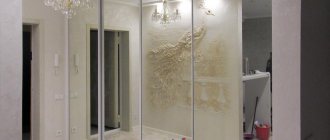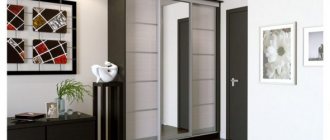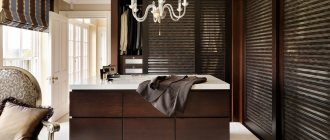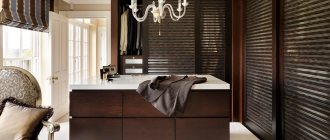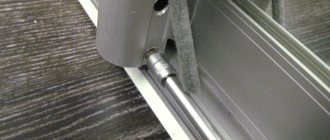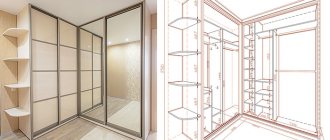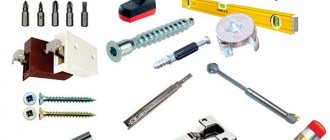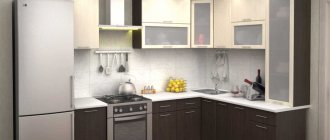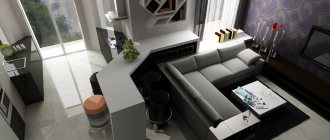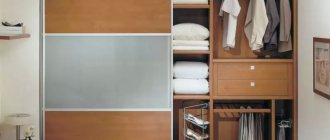Properly organized filling of a corner wardrobe will solve most of the problems of assembling things and simplify access to the most popular items. To achieve an optimal result, it is necessary to take into account a number of factors: select a suitable design; identify the important elements needed in the bedroom or hallway; you need to navigate the variety of modern devices available on the furniture market. All these points will be discussed in detail below.
The filling can be arranged according to your taste - the main thing is to plan in advance
Typical sizes of corner cabinets
The filling of a corner wardrobe directly depends on its dimensions and shape. These parameters are determined by the needs of the user, the purpose of the room and its area.
Triangular
This option is more common in spacious rooms. The lengths of the sides are the same and are never less than 1.2 m. The functionality of a structure with walls shorter than a meter is significantly reduced - some sections will have to be removed or made too small and inconvenient. One and a half meter sides, on the contrary, expand the possibilities for organizing the internal space, but take away the usable area of the room, which is why they are used less often.
The depth of the sections is 40-60 cm. The most common option is 45 cm; a maximum of 60 cm is suitable for arranging wardrobe departments. The width is selected depending on the purpose:
- compartments with shelves – up to 50 cm;
- with a hanger bar 80-90 cm;
- the outer side sections with an internal L-shaped layout are 30 cm.
L-shaped
The simplest and most popular form among users. Each wall is adjacent to a straight part, and the corner is filled with either a five-wall module with shelves, or this area is used as a compartment for storing things on hangers. Unlike triangular counterparts, L-shaped ones use the space of the room more efficiently and provide better access to the contents of the sections.
The walls of the structure can be either the same or different, with the minimum value usually about a meter, and the maximum can reach 2-2.5 m, depending on the layout. The depth is usually standard - 50-60 cm.
Examples of filling L-shaped cabinets for the hallway
Diagonal
In fact, it is a triangular cabinet with different sides. Main characteristics:
- The length of the smaller leg is from 70 cm; larger – up to 240 cm.
- Depth – 50-60 cm.
- Height – 170-250 cm.
The number of departments is determined by the larger wall. For example, with a length of 220 cm and a width of 70 cm, three compartments are made of approximately 70 cm each. If the length of the smaller leg is 1 meter or more, the outer section is adapted for shelves, and the rest of the space is left for a bar with hangers located on the larger side.
For diagonal structures, one side is always smaller than the other
Trapezoid shape
Unlike triangular analogues, here the diagonal is adjacent to the wall on one side and the side edge of the cabinet on the other. This option is considered more compact than those described above, since the space of the room is used more efficiently. The sides of the trapezoidal structures are not the same: the smaller one is about 80cm; large - at least 120 cm.
The dimensions and layout of the departments depend on the length of the walls and are practically no different from those for triangular and diagonal cabinets.
Radial
Thanks to the curved shape, they are characterized by greater capacity. The doors are made convex, follow the perimeter and move along a sector of the circle. Radius cabinets look unusual; small corner structures with equal walls resemble shower stalls. However, there are interesting design solutions that combine straight and concave shapes, which, together with the right material, gives quite impressive results.
The height of standard models is up to 2.5 m (minimum 1.8 m). The length of the rear walls, as a rule, is not less than a meter. The maximum dimensions are limited by the area of the room, its furnishings and user preferences.
The most correct, from the point of view of space saving, options are L-shaped and radius with a door concave inward. With this arrangement, there is no empty space in the middle, as in convex and triangular cabinets.
Facade selection
The appearance of the corner wardrobe depends on how the doors are designed. They are the ones who attract attention. They are made from:
- MDF and chipboard. Durable and relatively inexpensive materials. They have a lot of colors and textures: imitation of wood of different species and colors, colored smooth-painted surfaces with shine (glossy) or without (matte), designs and ornaments of different styles and types. Corner wardrobe with MDF facade
- Glass (usually frosted, patterned, colored). The glass used is thick, tempered. Some companies offer to apply some kind of design on glass. Usually there is a certain catalog from which you can choose the image you like. With glass doors, even a massive structure does not look so heavy
- Mirrors with possible application of drawings and ornaments using sandblasting. Mirrors are also used thick. They can also have different shades - gray, blue, yellowish, etc. shade. Drawings on the mirror are also usually made from catalogues, but some companies can realize your idea. Mirrors are almost a classic of the genre
- Photo printing is one of the possible coatings for chipboard doors, but due to its unique appearance it is usually placed in a separate category. A drawing or photograph is transferred to the film. The print quality is very high, the image is very realistic. This piece of furniture cannot be called inconspicuous
- Combinations of the materials and technologies described above. The most decorative effect is obtained by combining several materials. The number of combinations is very large and you can choose a front for a corner wardrobe to suit any interior and taste. Combining elements often looks more interesting
- Radial corner wardrobes. This is the name given to those models whose walls or facades are not straight, but curved. Such models look more modern, smooth lines.
Curved smooth lines look much better than broken or straight lines
With all this diversity, it is necessary to remember the influence of color on the perception of furniture. Since a corner wardrobe usually occupies a fairly large area, it largely determines the “sound” of the entire interior. Therefore, it is necessary to remember several truths. There aren't that many of them. First, mirrors push boundaries, expanding space. Light semi-gloss or glossy furniture and facades with light glass work approximately the same way. Secondly, dark furniture makes a small room even smaller. If you at least take this into account, there will be fewer questions.
Required components for an adult and child's bedroom
The contents in the bedroom do not have fixed standards and are selected in accordance with the user’s preferences. However, there are a number of components whose installation is considered generally accepted:
- Drawers. They usually store small items and items of clothing. For convenience, it is possible to install a finishing mechanism.
- Section for placing clothes on hangers. Usually this is the most spacious part, at least as wide as the hanger (55 cm).
- Shelves. Stationary or removable partitions are very convenient for folding laundry, things in boxes, travel bags and other items.
- Baskets. Special ventilated containers are used for linen and clothing. Items placed in the basket are easily accessible and well ventilated.
- Trousers. Pull-out or fixed holders designed for quick and convenient storage of trousers.
What's inside the triangular wardrobe in the bedroom
Required components for the hallway
The filling of a corner cabinet in the hallway most often consists of the following components:
- Outerwear department for storing items hung on hangers.
- A section with shelves for handbags and other small items that need quick access.
- Baskets (sometimes on rails with several tiers) are a popular option for hallways.
- The shoe rack is equipped with either gratings or special fastenings.
- Drawers with or without handles.
You can also place additional hangers, space for hats, corner compartments and seats.
Sometimes in the hallway you need to plan a place for large outdoor items
conclusions
If you already have a sofa and still have a corner to spare, you can afford to create extended seating by adding an interesting style set or a more sophisticated setting. The fireplace is definitely one of the most clever and creative corners to decorate such niches.
Floor lamps and oversized lamps are also great for decorating isolated corners with lighting. Workplaces and play corners are also a way to fill awkward spaces with the help of special furniture. Watch the video for even more ideas.
VIDEO: Incredibly beautiful bedrooms
Beautiful bedroom interior
Choosing a design
Shelves
Regardless of the location of the cabinet, it must have at least one compartment with shelves. It is convenient to put clothes, bedding and other small items in it. The location can be any: in the middle on the right or on the left - depending on the project and user preferences.
The distance between the shelves is determined by the items that are supposed to be stored on them:
- Under large boxes, pillows or blankets, leave a gap of 40-50 cm.
- For clothes, 35-40 cm will be enough. This is not convenient for everyone, because if you completely fill such a shelf with things and then pull something out from below, the whole order will be disrupted. Therefore, many prefer a distance of about 25 cm.
- The mezzanine sections are the most voluminous - 40-60 cm. If they are not divided horizontally, even such large items as travel bags or suitcases will fit there.
Expert opinion
Bashir Rabadanov
Technologist at the furniture company Woodband
The depth is determined depending on the size of the cabinet. The most convenient option is 50 cm; shelves smaller than 45 cm are rare, mainly in individual projects. The depth of 60 cm will be inconvenient if you need to get something folded near the far wall.
The best manufacturers
In the Central Federal District, together with Moscow and its region, 8 largest furniture enterprises are concentrated. They produce 25% of the total volume of products produced in the country. Second place goes to St. Petersburg. Other regions of Russia account for the remaining share of production.
The leading manufacturers of the Russian furniture industry are such companies as Shatura, Miass furniture, Kraft, Felix, Unitex, IKEA.
The undisputed leader is the trading and production company Stolplit. Its products are sold in 2,000 company stores located in 13 regions of Russia. The company's catalog can always be found on the Internet.
Boxes
Installed as one block consisting of two or more elements. It is not advisable to store massive objects in them; for example, you should not completely fill them with bed linen. Firstly, excessive load on the guides will lead to their premature failure. Secondly, the bottom of the box will quickly sag, since it is made of thin material (usually fiberboard, MDF), reinforced with chipboard slats.
Do not place the pull-out unit too low or on top of the cabinet. The optimal height is 90-120 cm from the floor. If the box is higher than 170 cm, it will be inconvenient to use. Standard sizes:
- width - 50 cm;
- height – 20 cm;
- depth – 45 cm.
Otherwise, the dimensions of the box depend on the compartment in which they will be located.
When making a custom cabinet, the drawers are usually built-in without an additional casing
Hangers
The most spacious department, designed to store things in their most natural state - on hangers. They are located on a special crossbar, which is mounted at a height of 140-180 cm from the floor. The minimum transverse size of the section should not be less than 60 cm (preferably 70-80 cm).
If the compartment is wide enough, it is possible to install several rods perpendicular to the doors, but the convenience of such an arrangement is questionable - things located near the wall are invisible and difficult to access. On the other hand, it becomes possible to sort: dresses on one bar, outerwear on another. The most convenient, but quite expensive option is retractable mechanisms located perpendicularly.
The minimum length of a standard crossbar is 50 cm. However, the dimensions of corner structures usually allow enough space to be allocated for a full meter section. The most common size is 100-120 cm.
Form
When arranging a small room, they often resort to tricks in order to optimally use the usable area. An ordinary rectangular cabinet will not always be appropriate here. Sometimes it is preferable to choose a corner design. To order, you can make a case of any shape:
- trapezoidal;
- triangular;
- pentagonal;
- L-shaped;
- radius, etc.
Shoe racks
Nets or shoe racks are installed at an angle in the lower part of the wardrobe located in the hallway. Storing shoes in the bedroom is quite rare, but it is also possible, for example, if they are out-of-season models. The optimal location is considered to be under the main bar with hangers.
Another option for shelves for shoes is special designs with a front part and an internal shelf. When closed, the shoe rack looks like a drawer, and access to the contents is provided by a rotating mechanism.
Wide pull-out shoe shelf built into the closet
Material
The cabinet consists of a frame, facade and internal filling. Since built-in models do not require back and sometimes side walls, more attention can be paid to the facades.
A metal profile or wooden beam is used for the frame. The side parts are usually made of MDF, chipboard or plastic.
For built-in wardrobes, you can use facades of various configurations:
- Sliding . As a rule, they use lightweight plastic with or without mirror coating. Laminated chipboard and MDF, glass are also often found. The array is rarely used, because it requires more powerful fittings.
- Swing . The doors simply swing open left or right. Natural wood and metal can be added to the above materials.
- Folding . They open by rotating around the horizontal axis of the lower or upper edge. Used to decorate small niches.
- Lifting . They rise up using a gas lift. Used for mezzanines and shelves located in the upper part of the cabinet.
- Accordion . The facade consists of several rectangular elements, which, when opened, are assembled in the form of an accordion. For their design, any materials are used, including fabric stretched over a frame.
In addition, the structure of the facades can be of different designs:
- straight;
- bent;
- with panels;
- smooth;
- with inserts;
- with stained glass;
- painted;
- with photo printing;
- sandblasting (monochrome and color);
- inlaid;
- with milled pattern;
- carved;
- painted;
- laminated.
Trousers
Designed for quick and convenient placement of more than one pair of trousers at a time. The hanger mount is compact and easily retractable. The optimal height is 120-140 cm from the floor. The width depends on the size of the section and usually does not exceed 70 cm, which allows you to place from 10 to 15 trousers, depending on the specific model. The minimum required depth of the cabinet is 60 cm. The height of the trouser rack is about 5 cm, and the space required for things placed on it is about 70 cm.
Metal trouser
In factory models, more than one trouser is not installed; when making to order, everything depends on the preferences of the future user.
Mezzanines or pantographs
Mezzanines are located at the very top and are not easy to reach without a chair or stepladder. This part is convenient for storing out-of-season clothes, blankets, pillows and other things that do not need quick access. Installing a mezzanine is not necessary, but without them, the unused space between the ceiling and the top of the cabinet will remain useless.
A pantograph is a kind of elevator to simplify access to the upper sections, which can be filled with shelves, rods or baskets. This is a worthy alternative to mezzanines; with its help you can implement modern, easy-to-use designs. However, such solutions are expensive, and cheap analogues do not last long.

